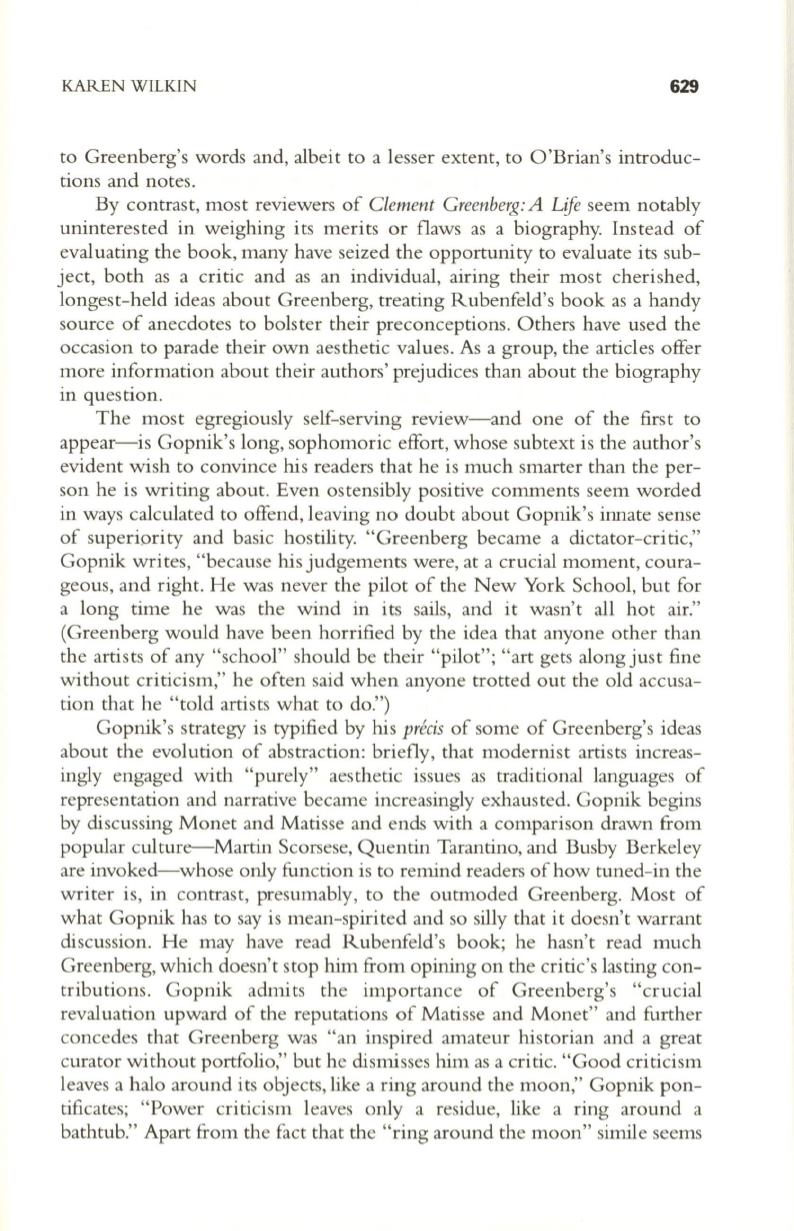
KAREN WILKIN
629
to Greenberg's words and, albeit to a lesser extent, to O 'Brian's introduc–
tions and notes.
By contrast, most reviewers of
Clement Greenberg: A Life
seem notably
uninterested in weighing its merits or flaws as a biography. Instead of
evaluating the book, many have seized the opportunity to evaluate its sub–
ject, both as a critic and as an individual, airing their most cherished,
longest-held ideas about Greenberg, treating Rubenfeld's book as a handy
source of anecdotes to bolster their preconceptions. Others have used the
occasion to parade their own aesthetic values. As a group, the articles offer
more information about their authors' prejudices than about the biography
in question.
The most egregiously self-serving review-and one of the first to
appear-is Gopnik's long, sophomoric effort, whose subtext is the author's
evident wish to convince his readers that he is much smarter than the per–
son he is writing about. Even ostensibly positive comments seem worded
in ways calculated to offend, leaving no doubt about Gopnik's innate sense
of superiority and basic hostility. "Greenberg became a dictator-critic,"
Gopnik writes, "because his judgements were, at a crucial moment, coura–
geous, and right. He was never the pilot of the New York School, but for
a long time he was the wind in its sails, and it wasn't all hot air."
(Greenberg would have been horrified by the idea that anyone other than
the artists of any "school" should be their "pilot"; "art gets along just fine
without criticism," he often said when anyone trotted out the old accusa–
tion that he "told artists what to do.")
Gopnik's strategy is typified by his
precis
of some of Greenberg's ideas
about the evolution of abstraction: briefly, that modernist artists increas–
ingly engaged with "purely" aesthetic issues as traditional languages of
representation and narrative became increasingly exhausted. Gopnik begins
by discussing Monet and Matisse and ends with a comparison drawn from
popular culture-Martin Scorsese, Quentin Tarantino, and Busby Berkeley
are invoked-whose only function is to remind readers of how tuned-in the
writer is, in contrast, presumably, to the outmoded Greenberg. Most of
what Gopnik has to say is mean-spirited and so silly that it doesn't warrant
discussion. He may have read Rubenfeld's book; he hasn't read much
Greenberg, which doesn't stop him from opining on the critic's lasting con–
tributions. Gopnik admits the importance of Greenberg's "crucial
revaluation upward of the reputations of Matisse and Monet" and further
concedes that Greenberg was "an inspired amateur historian and a great
curator without portfolio," but he dismisses him as a critic. "Good criticism
leaves a halo around its objects, like a ring around the moon," Gopnik pon–
tificates; "Power criticism leaves only a residue, like a ring around a
bathtub." Apart from the fact that the "ring around the moon" simile seems


